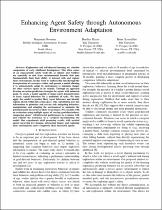JavaScript is disabled for your browser. Some features of this site may not work without it.
- ResearchSpace
- →
- Research Publications/Outputs
- →
- Conference Publications
- →
- View Item
| dc.contributor.author |
Rosman, Benjamin S

|
|
| dc.contributor.author |
Hayes, B

|
|
| dc.contributor.author |
Scassellati, B

|
|
| dc.date.accessioned | 2015-11-16T07:36:46Z | |
| dc.date.available | 2015-11-16T07:36:46Z | |
| dc.date.issued | 2015-08 | |
| dc.identifier.citation | Rosman, B.S., Hayes, B and Scassellati, B. 2015. Enhancing agent safety through autonomous environment adaptation. In: IEEE International Conference on Development and Learning and on Epigenetic Robotics, Providence, Rhode Island, USA, August 13-16, 2015 | en_US |
| dc.identifier.uri | http://www.benjaminrosman.com/papers/icdl15.pdf | |
| dc.identifier.uri | http://hdl.handle.net/10204/8291 | |
| dc.description | IEEE International Conference on Development and Learning and on Epigenetic Robotics, Providence, Rhode Island, USA, August 13-16, 2015 | en_US |
| dc.description.abstract | Exploration and self-directed learning are valuable components of early childhood development. This often comes at an unacceptable safety trade-off, as infants and toddlers are especially at risk from environmental hazards that may fundamentally limit their ability to interact with and explore their environments. In this work we address this risk through the incorporation of a caregiver robot, and present a model allowing it to autonomously adapt its environment to minimize danger for other (novice) agents in its vicinity. Through an approach focusing on action prediction strategies for agents with unknown goals, we create a model capable of using expert demonstrations to learn typical behaviors for a multitude of tasks. We then apply this model to predict likely agent behaviors and identify regions of risk within this action space. Our contribution uses this information to prioritize and execute risk mitigating behaviors, manipulating and adapting the environment to minimize the potential harm the novice is likely to encounter. We conclude with an evaluation using multiple agents of varying goal-directedness, comparing agents’ self-interested performance in scenarios with and without the assistance of a caregiver incorporating our model. Our experiments yield promising results, with assisted agents incurring less damage, interacting longer, and exploring their environments more completely than unassisted agents. | en_US |
| dc.language.iso | en | en_US |
| dc.publisher | IEEE | en_US |
| dc.relation.ispartofseries | Workflow;15678 | |
| dc.subject | Self-directed learning | en_US |
| dc.subject | Early childhood development | en_US |
| dc.subject | Environmental hazards | en_US |
| dc.subject | Caregiver robot | en_US |
| dc.subject | Varying goal-directedness | en_US |
| dc.subject | Self-interested performance | en_US |
| dc.title | Enhancing agent safety through autonomous environment adaptation | en_US |
| dc.type | Conference Presentation | en_US |
| dc.identifier.apacitation | Rosman, B. S., Hayes, B., & Scassellati, B. (2015). Enhancing agent safety through autonomous environment adaptation. IEEE. http://hdl.handle.net/10204/8291 | en_ZA |
| dc.identifier.chicagocitation | Rosman, Benjamin S, B Hayes, and B Scassellati. "Enhancing agent safety through autonomous environment adaptation." (2015): http://hdl.handle.net/10204/8291 | en_ZA |
| dc.identifier.vancouvercitation | Rosman BS, Hayes B, Scassellati B, Enhancing agent safety through autonomous environment adaptation; IEEE; 2015. http://hdl.handle.net/10204/8291 . | en_ZA |
| dc.identifier.ris | TY - Conference Presentation AU - Rosman, Benjamin S AU - Hayes, B AU - Scassellati, B AB - Exploration and self-directed learning are valuable components of early childhood development. This often comes at an unacceptable safety trade-off, as infants and toddlers are especially at risk from environmental hazards that may fundamentally limit their ability to interact with and explore their environments. In this work we address this risk through the incorporation of a caregiver robot, and present a model allowing it to autonomously adapt its environment to minimize danger for other (novice) agents in its vicinity. Through an approach focusing on action prediction strategies for agents with unknown goals, we create a model capable of using expert demonstrations to learn typical behaviors for a multitude of tasks. We then apply this model to predict likely agent behaviors and identify regions of risk within this action space. Our contribution uses this information to prioritize and execute risk mitigating behaviors, manipulating and adapting the environment to minimize the potential harm the novice is likely to encounter. We conclude with an evaluation using multiple agents of varying goal-directedness, comparing agents’ self-interested performance in scenarios with and without the assistance of a caregiver incorporating our model. Our experiments yield promising results, with assisted agents incurring less damage, interacting longer, and exploring their environments more completely than unassisted agents. DA - 2015-08 DB - ResearchSpace DP - CSIR KW - Self-directed learning KW - Early childhood development KW - Environmental hazards KW - Caregiver robot KW - Varying goal-directedness KW - Self-interested performance LK - https://researchspace.csir.co.za PY - 2015 T1 - Enhancing agent safety through autonomous environment adaptation TI - Enhancing agent safety through autonomous environment adaptation UR - http://hdl.handle.net/10204/8291 ER - | en_ZA |






